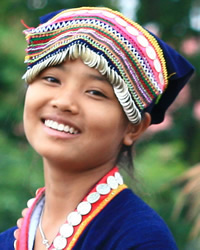Khmu in Vietnam

Photo Source:
Anonymous
|
Send Joshua Project a map of this people group.
|
| People Name: | Khmu |
| Country: | Vietnam |
| 10/40 Window: | Yes |
| Population: | 95,000 |
| World Population: | 911,200 |
| Primary Language: | Khmu |
| Primary Religion: | Ethnic Religions |
| Christian Adherents: | 1.00 % |
| Evangelicals: | 0.01 % |
| Scripture: | Portions |
| Ministry Resources: | Yes |
| Jesus Film: | Yes |
| Audio Recordings: | Yes |
| People Cluster: | Mon-Khmer |
| Affinity Bloc: | Southeast Asian Peoples |
| Progress Level: |
|
Introduction / History
The Khmu might have been in Southeast Asia as far back as 4,000-10,000 years. They use storytelling to preserve their history, and this method is eroding. Their history is in danger of being lost.
China is probably the original homeland of the Khmu and other tribes that at one time gradually migrated southward due to pressure by the Chinese. As they traveled, they conquered many people along the way. They speak various tongues which come from either the Mon Khmer or Tai group of languages. Most of the people are bilingual, speaking both their own language and the dominant language, in this case, Vietnamese.
The Khmu people live primarily in Laos and Vietnam, but smaller numbers live in southern China or Thailand. There are also diaspora communities in the United States and France.
What Are Their Lives Like?
Tribal people in Southeast Asia, like the Khmu, are primarily rice farmers, though they usually do some fishing and hunting as well. They have special storehouses for rice. These are elevated to keep mice from eating it. The Khmu cultivate a wide variety of crops, including various fruits and vegetables, for both consumption and trade. Like other Southeast Asian tribes, the Khmu work communally to maximize their productivity, but each family has their own private garden as well. These tribes are poorer than the dominant ethnic groups and therefore depend on them for many goods and services. Khmu villagers frequently meet with the Thai to trade their farm goods for necessary items such as clothing and salt. It is becoming more common for the Khmu people to raise pigs, goats, water buffalos, and other livestock to sell the meat.
Over the years, the tribes began adopting the practices of the surrounding peoples. This brought on many significant changes within their cultures. For example, they no longer use their traditional farming methods of burning and clearing plots. Instead, they grow wet rice on terraced plots, which is the agricultural method of the Thai. They also raise their cattle and till their fields. They prepare the fields with plows drawn by buffalo or oxen. Other Khmu people are farmhands, weavers or blacksmiths.
The Khmu usually made houses of wood or bamboo, but they are now using metal roofing. They build them on stilts above the ground, with farmland next to the residential areas. Domestic fowl, pigs, and goats may run freely underneath these houses.
Among the Khmu, the village is the most significant political unit of society. A headman leads each village, and the father leads each family.
What Are Their Beliefs?
The White Tai combines folk animism (the belief that non-living objects have spirits) with Buddhism. They worship various spirits and objects and also believe that people have multiple personal souls. They hold ceremonies for recalling the souls because they believe that this will strengthen the individual personality. The White Tai believe in spirits of the dead, the natural world, the political world, various localities, etc.PRGRPHMany White Tai are Buddhists. They are followers of Buddha ("the enlightened one") and seek to eliminate suffering and improve their future by gaining merit in pursuit of perfect peace, or nirvana. They believe that merit can be acquired through feeding monks, donating to temples, and attending worship services. Traditionally, young men enter village monasteries for about three months to study Buddhism.PRGRPHThey also believe in a supreme god who is active in their lives. According to their legends, their ancestors came out of a pumpkin in which they took refuge during a divinely decreed flood that drowned everyone on earth.
What Are Their Needs?
Their greatest need is to focus their faith in Jesus Christ, alone.
The White Tai people need spiritual hunger. They are satisfied with the spirituality of their ancestors, one which leaves them devoid of the grace, mercy and forgiveness of the only
Prayer Points
Pray for the Lord to give the Khmu people an abundant harvest this year as a testimony of his power and love.
Pray for the Khmu people to have hearts open to the abundant blessings of Jesus Christ.
Pray for their families to prosper financially and spiritually as they experience a relationship with Jesus Christ.
Pray for a movement to Christ among the Khmu to spread joy, peace and salvation to Southeast Asian peoples.